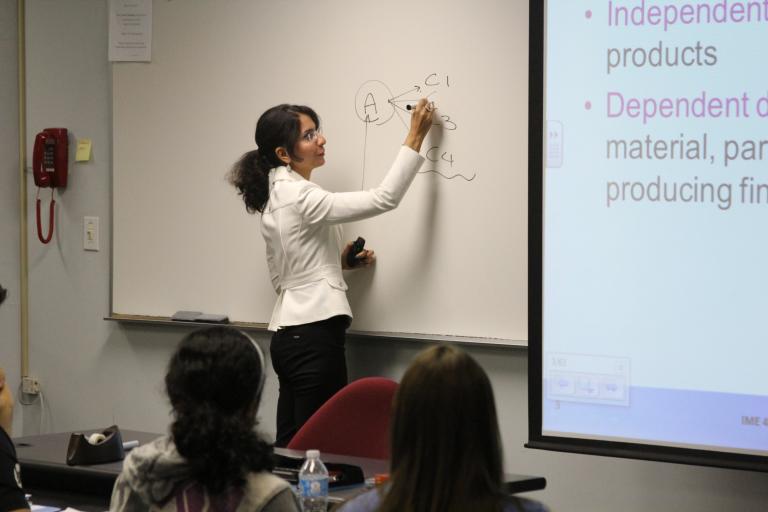
“If you consider an energy intensive process, we want to determine the best sequence of tasks to minimize the total time the product is flowing in the system and also minimize total energy consumption.”
Through her current research, Dr. Farnaz Ghazi-Nezami, Industrial Engineering faculty, is attempting to improve elements related to an engineering education and its practice in industry.
Ghazi-Nezami completed her doctorate in Industrial Engineering at Wichita State University. She also joined the Industrial and Manufacturing Engineering Department at WSU as an engineering educator where she embarked on a project evaluating the differences in student performance depending on the education medium. The three different instructional mediums that were analyzed were: online, traditional lecture and a flipped classroom that focuses on in-class discussions and problem solving over lecture. The study evaluated over 700 students across five semesters for the Engineering Economy class, a core course for all the engineering majors, and the results were consistent despite the perceptions and arguments for and against each of the mediums.
“There is no statistically significant difference in a student’s performance and perception of acquired knowledge in each of the mediums that the course was taught,” Ghazi-Nezami said. “The students learned exactly the same material, used the same sources and learned the same amount.”
Apart from performance, there were variations in student behavior. For example, student retention was higher in a traditional face-to-face classroom, but overall, the instructional mode does not appear to be a determining factor in performance.
“Our results are consistent with most of the literature,” Ghazi-Nezami said.
Ghazi-Nezami and her colleagues at WSU are currently in the process of publishing their findings as she simultaneously switches directions from engineering education to its practice.
Research at Kettering
At Kettering, Ghazi-Nezami has expanded her doctoral research on energy aware manufacturing operations. Traditionally, energy cost is considered fixed during the manufacturing process which leads to it being ignored. However, Ghazi-Nezami is attempting to alter that mindset.
“We want to integrate the concept of energy efficiency into operational systems,” Ghazi-Nezami said. “If you consider an energy intensive process, we want to determine the best sequence of tasks to minimize the total time the product is flowing in the system and also minimize total energy consumption.”
Ghazi-Nezami, along with one graduate and two undergraduate students, are examining analytical model models of scheduling and production.
In order to incorporate an energy efficiency concept into scheduling systems, the researchers must determine the allowable duration that machinery can be idle in a production system. The breakdown of energy consumption on manufacturing machineries shows that idle energy constitutes more than 80 percent of the total amount of energy used by a machine. A possible remedy: turning the machine off or switching to a low-energy consumption mode to save energy. However, there is also energy demand issues and potential risks with constantly turning heavy machinery on and off. It may also adversely influence total completion time for product processing and lead to a delay in the processing schedule. The balance in evaluation is then dependent on the energy consumption, energy demand, total completion time and system reliability.
For example, if you have a pile of rocks that need to be moved from one point to another, the energy consumption is the total energy required to move all the rocks. The energy demand is the energy threshold to move the largest rock - the maximum power that is required - and constitutes a significant percentage of industrial utility bills. This research on energy aware job scheduling can result in large-scale savings for manufacturers.
Ghazi-Nezami and her students are currently creating a simulation framework for this problem. Their next step is to work with a company to test the model with real data and then implement it across other industries.
“Once we get the data, it doesn’t matter the size of the problem,” Ghazi-Nezami said. “The model is very capable of giving us results. Once we get the real data we can implement it without any problems.”